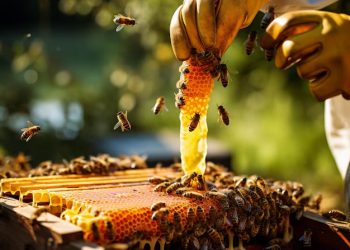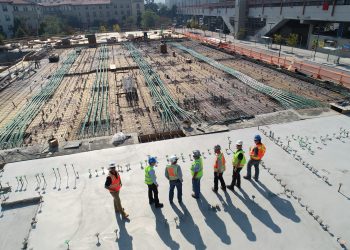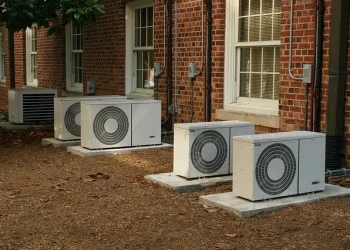Vertical axis wind turbine are of two types: iron core and ironless. The difference between them is mainly reflected in the power generation principle and structure.
1. Iron core generator:
Iron core generator is one of the traditional types of wind turbines. It contains an iron core, usually composed of iron sheets or silicon steel sheets, which is used to increase the magnetic induction intensity. The iron core generator uses the principle of magnetic induction to generate electrical energy through the interaction of magnetic fields between the rotor and the stator. The wind blows through the rotor, causing the rotor to rotate, and the permanent magnet (or excitation coil) on the rotor generates a magnetic field, which produces relative motion with the coil fixed on the stator, thereby generating an induced current in the coil.
① Structural characteristics of iron core generators
Iron core generators are a more traditional type of vertical axis wind turbines. Its core components include:
Iron core: usually made of laminated silicon steel sheets, it is an important part of the generator.
Stator winding: a wire coil fixed on the iron core.
Rotor: the rotating part with permanent magnets or excitation coils.
Bearing: A component that supports the rotation of the rotor.
Working principle of iron core generator
The working principle of iron core generator is based on Faraday’s law of electromagnetic induction. When the wind drives the rotor to rotate, the magnetic field generated by the permanent magnet or excitation coil on the rotor and the stator winding produce relative motion. This relative motion causes the magnetic lines of force to cut the stator winding, thereby inducing current in the winding.

② Advantages of iron core generator
High efficiency: The presence of the iron core can significantly enhance the magnetic field strength and improve the power generation efficiency.
High power density: Due to the concentration of the magnetic field, the iron core generator can produce greater output power at the same volume.
Good stability: The iron core structure makes the generator run more stably and reduces the magnetic field leakage.
Mature technology: The iron core generator technology is mature, and the design and manufacturing process are relatively simple.
③ Disadvantages of iron core generator
Heavy weight: The iron core increases the overall weight of the generator, and puts higher requirements on the support structure of the vertical axis wind turbine.
Eddy current loss: Eddy currents will be generated in the iron core, causing a certain amount of energy loss.
Cogging torque: Due to the iron core structure, cogging torque may be generated, affecting the starting performance of the generator.
Higher cost: The use of high-quality silicon steel sheets increases the manufacturing cost of the generator.
2. Coreless generator:
Coreless generator is also called linear generator or hollow shaft generator. Compared with iron core generator, it has no iron core structure. The coreless generator uses the interaction of the magnetic field between the hollow shaft and the stator to generate electrical energy.
The main difference lies in the way the magnetic field is formed. The iron core generator increases the magnetic induction intensity through the iron core, improves the power generation efficiency and output power, but also increases the complexity and weight of the structure. In contrast, the coreless generator has a simplified structure and lighter weight due to the lack of an iron core, but its power generation efficiency and power output may be relatively low.
The choice of using an iron core or a coreless generator usually depends on the specific application requirements. Iron core generators are suitable for occasions that require higher power output and high efficiency, such as commercial wind farms. Coreless generators are suitable for some small wind power generation systems or special environments, such as urban buildings, outdoor billboards, etc., because they have smaller size and weight.
① Structural features of coreless generators
Coreless generators, also known as linear generators or hollow shaft generators, have significantly different structures from cored generators:
Coreless structure: The traditional core is eliminated, greatly reducing weight.
Hollow stator: The windings are usually fixed with materials such as epoxy resin.
Permanent magnet rotor: High-performance permanent magnet materials such as NdFeB magnets are used.
Lightweight bearings: Special bearings adapted to lightweight design.
Working principle of coreless generators
Coreless generators also work based on the principle of electromagnetic induction. When the wind drives the permanent magnet rotor to rotate, the magnetic field directly moves relative to the hollow stator windings, inducing current in the windings. Since there is no core, the magnetic field is more evenly distributed, reducing local magnetic saturation.
② Advantages of coreless generators
Lightweight: There is no core, which greatly reduces the weight of the generator and is suitable for miniaturized applications.
Low starting speed: Since there is no cogging torque, coreless generators can start at lower wind speeds.
High efficiency: High efficiency at low speeds, suitable for variable speed operation.
Simple structure: Simplified structural design reduces manufacturing and maintenance costs.
③ Disadvantages of coreless generators
Low power density: Since there is no core to concentrate the magnetic field, the output power per unit volume is relatively small.
Heat dissipation challenge: The winding is directly exposed to the air, and the heat dissipation problem needs special consideration.
Low magnetic field utilization: The magnetic field lines are widely diffused, and the magnetic field utilization efficiency is not as high as that of cored generators.
Relatively new technology: As an emerging technology, further verification is required in some application fields.
3. In summary
Core generators and coreless generators differ in power generation principles and structures, and are suitable for different application scenarios and needs. The type of generator to be selected should be evaluated and selected according to the specific situation.
Core and coreless generators in vertical axis wind turbines each have their own unique advantages and applicable scenarios. Core generators dominate large wind power generation projects with their high efficiency and high power density. Coreless generators, on the other hand, have great potential in small distributed power generation and special application scenarios due to their lightweight and low starting wind speed.








